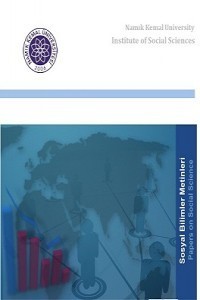Kurumsal Yönetim Notlarının Firmaların Finansal Performansları Üzerindeki Etkisi: BİST100 Endeksi Üzerine Bir Araştırma
Bu çalışmada, firmaların finansal performans ölçüleri olarak kullanılan Özsermaye Karlılığı Rasyosu (ROE), Aktif Karlılık Rasyosu (ROA), ve Fiyat Kazanç Oranı (F/K), Türkiye'de kurumsal yönetim ve alt-kategori skorlarının firmaların finansal performansları üzerindeki etkisini incelemek için kullanılmıştır. Veri seti dengeli olmayan bir veri seti olup 2007-2013 yılları arasında BİST100 endeksinde yer alan ve kurumsal yönetim endekine dahil olan firmaları kapsamaktadır. Çalışma sonuçları tüm veri seti ve finansal olmayan firmalardan oluşan veri seti olmak üzere iki bölüm halinde analiz edilmiştir. Her iki veri seti için, kurumsal yönetim notlarının endeksteki firmaların finansal performans üzerinde istatistiksel anlamlı bir etkisi tespit edilememiştir. Yani, daha yüksek kurumsal yönetim notu daha yüksek finansal performans anlamına gelmemektedir. Paydaş notları ile firmaların finansal performansları arasından istatistiksel anlamlı ve pozitif bir ilişki tespit edilmiştir. Daha yüksek paydaş notuna sahip olan firmalar diğer firmalara kıyasala daha iyi finansal performans göstermektedirler.
Anahtar Kelimeler:
Kurumsal Yönetim, Kurumsal Yönetim Derecelendirme, Kurumsal Yönetim İndeksi, BİST100, Türkiye
The Effect of Corporate Governance Scores on Firms’ Financial Performance: Evidence on BIST100 Index
In this study, Return on Equity Ratio (ROE), Return on Assets Ratio (ROA), and Price-Earnings Ratio (P/E) are determined as the financial performance measures of listed firms to test the effect of overall corporate governance scores and sub-categories scores on financial performance in Turkey. The study covers an unbalanced data set from Bist100 firms which are listed in corporate governance index between the years 2007-2013. The study results are analyzed for the full data set and for the non-financial firms’ data set. For each set, the analysis results reveal that corporate governance scores have no statistically significant effect on listed firms’ financial performance. Therefore, getting higher corporate governance scores don’t mean higher performance for those firms. Besides, there is a statistically significant and positive relationship between stakeholders’ scores and financial performance. In other words, firms with higher stakeholders’ scores show comparatively higher financial performance.
Keywords:
Corporate Governance, Corporate Governance Rating, Corporate Governance Index, BİST100, Turkey,
___
- Akdogan, Y. E. & Boyacioglu, A. (2014). The Effect of Corporate Governance on Firm Performance: A Case of Turkey. International Journal of Critical Accounting, 6 (2),187-210. Bebchuk, L., Cohen, A. & Ferrell, A. (2004). What Matters in Corporate Governance? Unpublished Working Paper, Harvard Law School. Bhagat, S. & Bolton B. (2008). Corporate Governance and Firm Performance. Journal of Corporate Finance, 14, 257-273. Breusch, T. S. & Pagan, A.R. (1980). The Lagrange Multiplier Test and Its Applications to Model Specification in Econometrics. Review of Economic Studies, 47 (1), 239-253,. Brown, D., L. & Caylor, L. M. (2004). Corporate Governance and Firm Performance. Unpublished Working Paper, Georgia State University. Brown, D. L, & Caylor, L. M. (2006). Corporate Governance and Firm Valuation. Journal of Accounting and Public Policy. 25, 409-434. CMB. (2007). Communique on Principles Regarding Ratings and Rating Agencies by Capital Market Board. Serial:VIII, No.51. Official Gazette: 26580. CMB. (2014). Communiqué on Corporate Governance. Official Gazette:28871. Cremers, M. & Nair, V. B. (2005). Governance Mechanisms and Equity Prices. Journal of Finance, 60 (6), 2859-2894. Dagli, H., Ayaydin, H. & Eyuboglu, K. (2010). Kurumsal Yönetim Endeksi Performans Değerlendirmesi: Türkiye Örneği. Mufad Journal, 48,18-31,. Erdogan Coskun, D. & Demir, Y. (2015). Kurumsal Yönetim Endeksine Dahil Olmanın Firmanın Finansal Performansına Etkisi: 2007-2013 Bist 100 Örneği. Sosyal Bilimler Metinleri, 4, 1-19. Erdogan, S. (2015). Finansal Skandalların Bağımsız Denetim Boyutu. Mali Çözüm, 25 (128), 15-32. Ertuğrul, M. & Hegde, S. (2009). Corporate Governance Ratings and Firm Performance. Finance Manage, 38 (1), 139-160. Gompers, P., Ishii, J. & Metrick, A. (2003). Corporate Governance and Equity Prices. Quarterly Journal of Economics, 118, 107-155. Gupta, P. P., Kennedy, B. D. & Weaver, C. S. (2009). Corporate Governance and Firm Performance: Evidence from Canadian Capital Markets. Corporate Ownership and Control Journal, 6 (3), 1-35. Hausman, J. A. (1978). Specification Tests in Econometrics. Econometrica. 46 (6), 1251–1271. Heenetigala, K. & Armstrong, A. F. (2011). The Impact of Corporate Governance on Firm Performance in an Unstable Economic and Political Environment: Evidence from Sri Lanka. 3th Conference on Financial Markets and Corporate Governance, 1-17. Javaid, F. & Saboor, A. (2015). Impact of Corporate Governace Index on Firm Performance: Evidence from Pakistani Manufacturing Sector. Journal of Public Administration and Governance, 5 (2), 1-21. Karamustafa, O, Varici, I. & Er, B. (2009). Kurumsal Yönetim ve Firma Performansı: IMKB Kurumsal Yönetim Endeksi Kapsamındaki Firmalar Üzerinde Bir Uygulama. Kocaeli Üniversitesi Sosyal Bilimler Enstitüsü Dergisi, 17 (1), 100-119. Maher, M. and Andersson, T. (1999). Corporate Governance: Effects on Firm Performance and Economic Growth, OECD: Organisation for Economic Co-Operation and Development. 1-51. OECD. (2015). G20/OECD Principles of Corporate Governance, OECD Publishing, Paris. Erişim Tarihi: 14.12.2016, http://dx.doi.org/10.1787/9789264236882-en. Yilmaz, C. & Buyuklu, A. H. (2016). Impacts of Corporate Governance On Firm Performance: Turkey Case With A Panel Data Analysis. Eurasian Journal of Economics and Finance, 4(1), 56-72.
- ISSN: 1308–4453/1308–4895
- Yayın Aralığı: Yılda 2 Sayı
- Başlangıç: 2008
